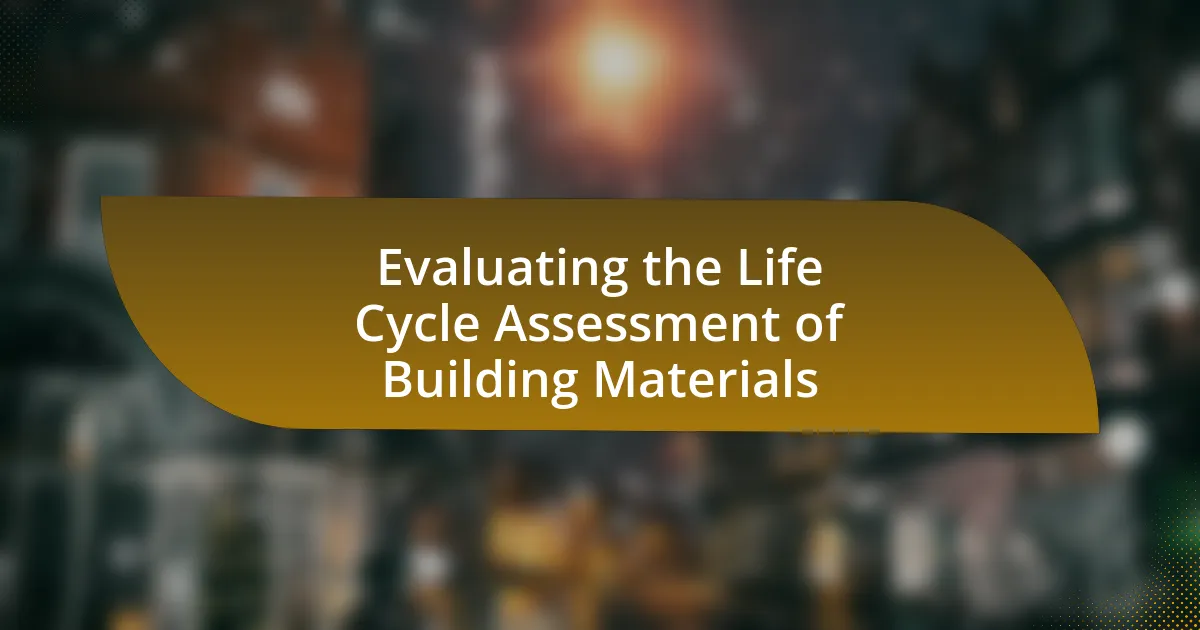Life Cycle Assessment (LCA) of building materials is a systematic evaluation process that assesses the environmental impacts of materials throughout their entire life cycle, from raw material extraction to disposal. The article outlines the four key phases of LCA—goal and scope definition, inventory analysis, impact assessment, and interpretation—highlighting their importance in sustainable construction practices. It emphasizes the significance of LCA in material selection, its methodologies, and the challenges faced in data collection and analysis. Additionally, the article discusses the role of ISO standards in guiding LCA practices and the necessity for collaboration among stakeholders to enhance accuracy and effectiveness in evaluating the environmental performance of building materials.
-of-Building-Materials-1.webp)
What is Life Cycle Assessment (LCA) of Building Materials?
Life Cycle Assessment (LCA) of building materials is a systematic process for evaluating the environmental impacts associated with all stages of a building material’s life, from raw material extraction through production, use, and disposal. LCA quantifies resource consumption and emissions, providing a comprehensive view of the material’s sustainability. According to ISO 14040 standards, LCA includes four phases: goal and scope definition, inventory analysis, impact assessment, and interpretation, which collectively help stakeholders make informed decisions regarding material selection and environmental performance.
How is LCA defined in the context of building materials?
Life Cycle Assessment (LCA) in the context of building materials is defined as a systematic process for evaluating the environmental impacts associated with all stages of a building material’s life, from raw material extraction through production, use, and disposal. This assessment quantifies energy consumption, emissions, and resource depletion, providing a comprehensive view of the material’s sustainability. According to the ISO 14040 standard, LCA encompasses four phases: goal and scope definition, inventory analysis, impact assessment, and interpretation, ensuring a thorough evaluation of environmental performance throughout the material’s lifecycle.
What are the key stages of LCA for building materials?
The key stages of Life Cycle Assessment (LCA) for building materials are goal and scope definition, inventory analysis, impact assessment, and interpretation. In the goal and scope definition stage, the purpose of the assessment and the boundaries of the study are established. The inventory analysis stage involves compiling data on energy and material inputs and outputs throughout the life cycle of the building materials. The impact assessment stage evaluates the potential environmental impacts based on the inventory data, often using specific indicators. Finally, the interpretation stage involves analyzing the results to make informed decisions and recommendations. These stages collectively ensure a comprehensive evaluation of the environmental performance of building materials.
Why is LCA important for sustainable construction?
LCA, or Life Cycle Assessment, is important for sustainable construction because it provides a comprehensive evaluation of the environmental impacts associated with all stages of a building’s life cycle, from raw material extraction to disposal. By quantifying resource use, energy consumption, and emissions, LCA enables architects and builders to make informed decisions that minimize negative environmental effects. For instance, a study published in the Journal of Cleaner Production found that using LCA can reduce greenhouse gas emissions by up to 30% in construction projects. This data underscores LCA’s role in promoting sustainable practices and enhancing the overall sustainability of the built environment.
What are the main objectives of conducting an LCA?
The main objectives of conducting a Life Cycle Assessment (LCA) are to evaluate the environmental impacts of a product throughout its entire life cycle, from raw material extraction to disposal. This comprehensive analysis helps identify opportunities for reducing resource consumption and minimizing waste, thereby promoting sustainability. Additionally, LCA supports decision-making by providing data that can guide product design, material selection, and policy development, ultimately leading to more environmentally friendly practices in industries such as construction and manufacturing.
How does LCA contribute to environmental impact reduction?
Life Cycle Assessment (LCA) contributes to environmental impact reduction by systematically evaluating the environmental effects of a product throughout its entire life cycle, from raw material extraction to disposal. This comprehensive approach allows stakeholders to identify areas where resource use and emissions can be minimized, leading to more sustainable practices. For instance, a study published in the Journal of Cleaner Production found that implementing LCA in the construction sector can reduce greenhouse gas emissions by up to 30% by optimizing material choices and construction processes. By providing data-driven insights, LCA enables informed decision-making that prioritizes environmental sustainability in building material selection and usage.
What role does LCA play in material selection for construction projects?
Life Cycle Assessment (LCA) plays a critical role in material selection for construction projects by providing a comprehensive evaluation of the environmental impacts associated with different materials throughout their entire life cycle. This assessment includes stages such as raw material extraction, production, transportation, use, and end-of-life disposal or recycling. By utilizing LCA, construction professionals can identify materials that minimize negative environmental effects, such as carbon emissions and resource depletion, thereby promoting sustainability in building practices. Studies have shown that LCA can lead to more informed decision-making, resulting in the selection of materials that not only meet performance criteria but also align with environmental goals, ultimately contributing to more sustainable construction outcomes.

What methodologies are used in LCA for building materials?
Life Cycle Assessment (LCA) for building materials employs several methodologies, including the process-based approach, input-output analysis, and hybrid methods. The process-based approach focuses on quantifying the environmental impacts of each stage of a material’s life cycle, from raw material extraction to disposal, using detailed data on processes and emissions. Input-output analysis, on the other hand, utilizes economic data to assess the environmental impacts associated with the entire economy, linking industries and their resource use. Hybrid methods combine both process-based and input-output approaches to provide a more comprehensive assessment. These methodologies are validated by standards such as ISO 14040 and ISO 14044, which outline the principles and framework for conducting LCA, ensuring consistency and reliability in the evaluation of building materials.
What are the common LCA frameworks and standards?
Common Life Cycle Assessment (LCA) frameworks and standards include ISO 14040 and ISO 14044, which provide guidelines for conducting LCA studies. These standards outline the principles and framework for LCA, including goal and scope definition, inventory analysis, impact assessment, and interpretation. Additionally, the Product Environmental Footprint (PEF) and the Corporate Social Responsibility (CSR) frameworks are widely recognized in the EU for assessing environmental impacts. The American Society for Testing and Materials (ASTM) also offers standards such as ASTM E2921, which focuses on the LCA of building materials. These frameworks and standards ensure consistency and reliability in LCA practices across various industries.
How do ISO standards influence LCA practices?
ISO standards significantly influence Life Cycle Assessment (LCA) practices by providing a structured framework for conducting assessments. Specifically, ISO 14040 and ISO 14044 outline the principles and requirements for LCA, ensuring consistency and reliability in the evaluation process. These standards promote transparency, reproducibility, and comparability of LCA results, which are essential for stakeholders in the building materials sector. For instance, adherence to these ISO standards helps organizations systematically identify environmental impacts throughout the life cycle of building materials, from raw material extraction to disposal. This structured approach enhances decision-making and supports sustainable practices in the construction industry.
What are the differences between various LCA methodologies?
Various Life Cycle Assessment (LCA) methodologies differ primarily in their approaches to data collection, impact assessment, and system boundaries. For instance, the ISO 14040/44 framework emphasizes a standardized process for LCA, focusing on transparency and reproducibility, while the ReCiPe method integrates midpoint and endpoint indicators to provide a more comprehensive impact assessment. Additionally, the Eco-Indicator 99 methodology prioritizes environmental impacts by assigning monetary values to damages, which contrasts with the more qualitative approaches of other methodologies. These differences affect the outcomes and applicability of LCA results in evaluating building materials, as each methodology may yield varying insights into environmental impacts based on its specific focus and assumptions.
How is data collected and analyzed in LCA?
Data in Life Cycle Assessment (LCA) is collected through a combination of primary and secondary data sources. Primary data is gathered directly from the processes being assessed, such as manufacturing, transportation, and usage of building materials, often through surveys, interviews, and direct measurements. Secondary data is sourced from existing databases, literature, and industry reports that provide information on material properties, energy consumption, and emissions associated with various life cycle stages.
The analysis of this data involves quantitative methods, including inventory analysis to quantify inputs and outputs, impact assessment to evaluate potential environmental effects, and interpretation to draw conclusions and make recommendations. For instance, the use of software tools like SimaPro or GaBi facilitates the modeling and analysis of complex data sets, allowing for a comprehensive evaluation of environmental impacts across the life cycle of building materials.
What types of data are essential for accurate LCA results?
Accurate Life Cycle Assessment (LCA) results require comprehensive data on material inputs, energy consumption, emissions, and waste generation throughout the product’s life cycle. Specifically, data on raw material extraction, manufacturing processes, transportation, usage, and end-of-life disposal are crucial. For instance, the International Organization for Standardization (ISO) 14040 series emphasizes the importance of collecting detailed inventory data to ensure reliable assessments. Additionally, accurate emission factors and energy use statistics are vital for quantifying environmental impacts, as highlighted in the “Guidelines for Life Cycle Assessment: A ‘Code of Practice’” by the Society of Environmental Toxicology and Chemistry.
How do software tools facilitate LCA analysis?
Software tools facilitate Life Cycle Assessment (LCA) analysis by automating data collection, processing, and interpretation, which enhances efficiency and accuracy. These tools enable users to model complex systems, assess environmental impacts, and generate reports based on standardized methodologies, such as ISO 14040 and ISO 14044. For instance, software like SimaPro and GaBi provides databases with life cycle inventory data, allowing for comprehensive assessments of building materials’ environmental performance. This integration of data and modeling capabilities supports informed decision-making in sustainable material selection and design processes.

What are the challenges in evaluating LCA of building materials?
Evaluating the Life Cycle Assessment (LCA) of building materials faces several challenges, including data availability, variability in methodologies, and the complexity of systems. Data availability is often limited, as comprehensive datasets on material production, transportation, and end-of-life scenarios are not always accessible. Variability in methodologies arises from differing standards and approaches used in LCA studies, which can lead to inconsistent results. Additionally, the complexity of building systems, including interactions between materials and their environmental impacts over time, complicates the assessment process. These challenges hinder accurate comparisons and decision-making regarding sustainable building practices.
What limitations exist in current LCA practices?
Current Life Cycle Assessment (LCA) practices face several limitations, including data availability, methodological inconsistencies, and a lack of standardization. Data availability is often restricted due to incomplete or inaccessible information on material production processes, which hinders accurate assessments. Methodological inconsistencies arise from varying approaches to impact categories and assessment frameworks, leading to divergent results across studies. Additionally, the absence of standardized guidelines for LCA implementation complicates comparisons between different assessments, reducing their reliability and applicability in decision-making. These limitations collectively undermine the effectiveness of LCA in evaluating the environmental impacts of building materials.
How do data quality and availability affect LCA outcomes?
Data quality and availability significantly influence Life Cycle Assessment (LCA) outcomes by determining the accuracy and reliability of the environmental impact evaluations. High-quality data ensures that the inputs and processes analyzed reflect real-world conditions, leading to more precise assessments of resource use, emissions, and overall sustainability. Conversely, poor data quality can result in misleading conclusions, as inaccuracies may propagate through the LCA model, affecting decision-making. For instance, a study published in the Journal of Cleaner Production found that using high-quality, region-specific data improved the reliability of LCA results by up to 30%, highlighting the critical role of data in achieving valid assessments. Additionally, the availability of comprehensive datasets allows for a more thorough analysis of various life cycle stages, enhancing the robustness of the findings.
What are the common misconceptions about LCA in the construction industry?
Common misconceptions about Life Cycle Assessment (LCA) in the construction industry include the belief that LCA only considers environmental impacts, neglecting social and economic factors. In reality, LCA evaluates a product’s entire life cycle, including resource extraction, manufacturing, use, and disposal, while also integrating social and economic dimensions in some frameworks. Another misconception is that LCA results are definitive and universally applicable; however, LCA outcomes can vary significantly based on the specific context, assumptions, and data used, making them context-dependent rather than absolute. Additionally, many assume that LCA is too complex and costly for practical use, but advancements in software and methodologies have made LCA more accessible and cost-effective for construction projects.
How can stakeholders improve LCA evaluations?
Stakeholders can improve Life Cycle Assessment (LCA) evaluations by enhancing data quality and transparency throughout the assessment process. By collaborating to gather accurate, region-specific data and sharing methodologies, stakeholders can ensure that LCA results reflect real-world conditions. For instance, the use of standardized databases, such as the Ecoinvent database, provides reliable data that can enhance the credibility of LCA findings. Additionally, engaging in continuous training and education on LCA methodologies allows stakeholders to stay updated on best practices, thereby improving the overall rigor and relevance of evaluations.
What best practices should be followed for effective LCA implementation?
Effective Life Cycle Assessment (LCA) implementation requires a systematic approach that includes defining clear goals and scope, selecting appropriate methodologies, and ensuring data quality. Establishing specific objectives helps to focus the assessment on relevant environmental impacts, while choosing a suitable LCA framework, such as ISO 14040/44, provides a structured process. High-quality, region-specific data enhances the accuracy of results, as demonstrated by studies indicating that data quality significantly influences LCA outcomes. Additionally, engaging stakeholders throughout the process fosters transparency and improves the credibility of the assessment.
How can collaboration among stakeholders enhance LCA accuracy?
Collaboration among stakeholders enhances Life Cycle Assessment (LCA) accuracy by integrating diverse expertise and data sources, which leads to more comprehensive assessments. When architects, engineers, manufacturers, and environmental scientists work together, they can share critical information about material properties, production processes, and environmental impacts. This collective input helps identify gaps in data and assumptions, thereby refining the LCA methodology. For instance, a study published in the Journal of Cleaner Production demonstrated that multi-stakeholder collaboration improved data quality and reduced uncertainty in LCA results by up to 30%. By leveraging the unique insights of each stakeholder, the overall accuracy and reliability of LCA outcomes are significantly enhanced.
What practical steps can be taken to apply LCA in building projects?
To apply Life Cycle Assessment (LCA) in building projects, practitioners should follow these practical steps: first, define the scope and boundaries of the assessment, including the functional unit and system boundaries. Next, collect data on material inputs, energy consumption, and emissions throughout the building’s life cycle phases—raw material extraction, manufacturing, construction, use, and end-of-life. Then, utilize LCA software tools, such as SimaPro or GaBi, to analyze the data and assess environmental impacts based on established impact categories like global warming potential and resource depletion. Finally, interpret the results to inform decision-making, optimize material selection, and improve sustainability practices in the building project. These steps are validated by the ISO 14040 and ISO 14044 standards, which provide a framework for conducting LCA effectively.
